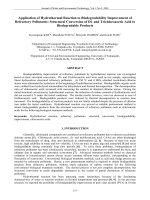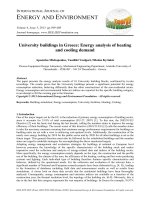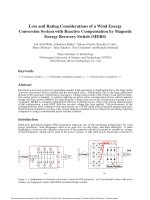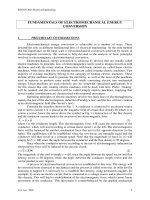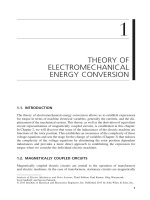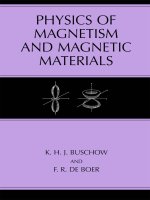Lecture Electromechanical energy conversion: Magnetic circuits and magnetic materials - Nguyễn Công Phương
Bạn đang xem bản rút gọn của tài liệu. Xem và tải ngay bản đầy đủ của tài liệu tại đây (1.79 MB, 49 trang )
Nguyễn Công Phương
ELECTROMECHANICAL ENERGY
CONVERSION
Magnetic Circuits
and Magnetic Materials
Contents
I. Magnetic Circuits and Magnetic Materials
II. Electromechanical Energy Conversion
Principles
III. Introduction to Rotating Machines
IV. Synchronous Machines
V. Polyphase Induction Machines
VI. DC Machines
VII.Variable – Reluctance Machines and Stepping
Motors
VIII.Single and Two – Phase Motors
IX. Speed and Torque Control
sites.google.com/site/ncpdhbkhn
2
Magnetic Circuits
and Magnetic Materials
1.
2.
3.
4.
5.
6.
Introduction to Magnetic Circuits
Flux Linkage, Inductance, and Energy
Properties of Magnetic Materials
AC Excitation
Permanent Magnets
Application of Permanent Magnet Materials
sites.google.com/site/ncpdhbkhn
3
Introduction to Magnetic Circuits
(1)
∫ H.dL = ∫
S
∫
S
J.dS
B.dS = 0
B = µH
•
•
•
•
H:
J:
B:
µ:
magnetic field intensity, A/m
current density, A/m2
magnetic flux density, Wb/m2 (T)
permeability, H/m
sites.google.com/site/ncpdhbkhn
4
Introduction to Magnetic Circuits
(2)
6
4
2
0
-2
-4
-6
1
1
0.5
0.5
0
0
∫ H.dL = ∫
S
-0.5
J.dS
-0.5
-1
-1
sites.google.com/site/ncpdhbkhn
5
Introduction to Magnetic Circuits
(3)
∫ H.dL = ∫
S
J.dS
sites.google.com/site/ncpdhbkhn
6
Introduction to Magnetic Circuits
(4)
∫
S
B.dS = 0
sites.google.com/site/ncpdhbkhn
7
Introduction to Magnetic Circuits
Magnetic flux Φ (5)
Mean core length, l
c
i
+
Cross-sectional area, Sc
–
Air gap, length g,
permeability µ0,
area Sg
Winding, N turns
Magnetic core permeability µ
µ >> µ0 :
the magnetic flux is confined
almost entirely to the core
F = Ni :
magnetomotive force (mmf)
sites.google.com/site/ncpdhbkhn
8
Introduction to Magnetic Circuits
Magnetic flux Φ (6)
Mean core length, l
c
i
+
Cross-sectional area, Sc
–
Air gap, length g,
permeability µ0,
area Sg
Winding, N turns
Magnetic core permeability µ
Φ = ∫ B.dS
F = Ni =
S
B c ≈ const
∫ H.dL
H c ≈ const
→ Φ c = Bc S c
sites.google.com/site/ncpdhbkhn
→ F = H c lc
9
Introduction to Magnetic Circuits
Magnetic flux Φ (7)
Mean core length, l
c
i
+
Cross-sectional area, Sc
–
Air gap, length g,
permeability µ0,
area Sg
Winding, N turns
Magnetic core permeability µ
F = Ni =
∫ H.dL = H l
c c
+ H glg
→F=
Bc
lc +
Bg
g
µ
µ0
Bc = µ H c ;
Bg = µ0 H g
Φ c = Bc Sc ; Φ g = Bg S g ; Φ c = Φ g = Φ
lc
g
→ F = Φ
+
µ Sc µ0 S g
sites.google.com/site/ncpdhbkhn
10
Introduction to Magnetic Circuits
(8)
lc
g
F = Φ
+
µ Sc µ0 S g
lc
g
= Rc ;
= Rg
µ Sc
µ0 S g
→ F = Φ ( Rc + Rg )
F
F
F
→Φ=
=
=
= Ptotal F
lc
g
Rc + Rg
R
total
+
µ S c µ0 S g
sites.google.com/site/ncpdhbkhn
11
Ex. 1
Introduction to Magnetic Circuits
Φ
(9)
Given Bc = 1T, lc = 40cm, g = 0.05cm,
N = 1000 turns, Sc = Sg = 16cm2,
µ = 65000µ0. Find:
a) The reluctances Rc & Rg?
b) The flux Φ?
c) The current i?
lc
Sc
i
+
g,
µ0,
Sg
–
N turns
µ
lc
40 × 10−2
A. turns
Rc =
=
= 3061
−7
−4
µ Sc 65000(4π × 10 )(16 × 10 )
Wb
g
0.05 × 10−2
5 A. turns
Rg =
=
= 2.49 × 10
−7
−4
µ0 S g (4π × 10 )(16 × 10 )
Wb
Φ = Bc Sc = 1 × 16 × 10−4 = 16 × 10−4 Wb
F Φ ( Rc + Rg ) 16 × 10−4 (3061 + 2.49 × 105 )
i= =
=
= 0.41A
N
N
1000
sites.google.com/site/ncpdhbkhn
12
Ex. 2
Introduction to Magnetic Circuits
Φ
(10)
Given Φ = 0.141 mWb, Sc = Sg = 4cm2,
lc = 44cm, g = 0.02cm, N = 400 turns.
The core is made of nickel – iron alloy.
Find the current i?
Φ 0.141 × 10−3
Bc =
=
= 0.35T
−
4
Sc
4 × 10
→ H c = 850 A/m
lc
Sc
i
+
g,
µ0,
Sg
–
N turns
µ
B (T)
sites.google.com/site/ncpdhbkhn
H (A/m)
13
Ex. 2
Introduction to Magnetic Circuits
Φ
(11)
Given Φ = 0.141 mWb, Sc = Sg = 4cm2,
lc = 44cm, g = 0.2cm, N = 400 turns.
The core is made of nickel – iron alloy.
Find the current i?
Φ 0.141 × 10−3
Bc =
=
= 0.35T
−
4
Sc
4 × 10
→ H c = 850 A/m
lc
Sc
i
+
g,
µ0,
Sg
–
N turns
µ
Bg
Φ 0.141 × 10 −3
0.35
5
Bg =
=
=
0.35T
→
H
=
=
=
2.79
×
10
A/m
g
−
4
−
7
Sg
µ0 4π × 10
4 × 10
F = H c lc + H g l g = 850 × 0.44 + 2.79 × 105 × 2 × 10 −3 = 931A. turns
F 931
→i=
=
= 2.33 A
N 400
sites.google.com/site/ncpdhbkhn
14
Ex. 3
Introduction to Magnetic Circuits
(12)
Given i = 10 A, Sg = 1500 cm2, g = 2 cm,
N = 500 turns. Rotor and stator are made
of iron (infinite permeability). Find the
flux of the air gap?
F
Ni
Φ=
=
lc
g
Rc + Rg
+
µ S c µ0 S g
µ→∞
g
i
N turns
Ni µ0 S g 500 × 10(4π × 10−7 )1500 × 10 −4
→Φ=
=
= 0.024 Wb
−2
2g
2 × 2 × 10
sites.google.com/site/ncpdhbkhn
15
Ex. 4
Introduction to Magnetic Circuits
(13)
i
+
l1
Ф1
Ф2
–
l3
l2
Ф3
N turns
F = Ni = H1l1 + H 2l2
H 2l2 = H 3l3
Φ = Φ + Φ
1
2
3
sites.google.com/site/ncpdhbkhn
16
Magnetic Circuits
and Magnetic Materials
1.
2.
3.
4.
5.
6.
Introduction to Magnetic Circuits
Flux Linkage, Inductance, and Energy
Properties of Magnetic Materials
AC Excitation
Permanent Magnets
Application of Permanent Magnet Materials
sites.google.com/site/ncpdhbkhn
17
Flux Linkage, Inductance, and
Energy (1)
d
∫ C E.dL = − dt ∫S B.dS
dϕ d λ
e=N
=
,
dt
dt
L=
ϕ=
λ = Nϕ
λ
i
F
Rtotal
F = Ni
N2
→L=
Rtotal
sites.google.com/site/ncpdhbkhn
18
Flux Linkage, Inductance, and
Energy (2)
Ex. 1
Find the inductance of the winding and
the flux density of gap 2?
L=
λ
+
λ
−
g
g
R1 = 1 , R2 = 2
µ0 S1
µ0 S2
Rtotal =
Area
S1
i
Gap1
Area S1
g2
Gap 2
N turns
R1R2
g1 g 2
=
R1 + R2 µ0 ( g1S 2 + g 2 S1 )
g1
µ→∞
φ
Nφ
i
i
Ni
φ=
Rtotal
=
+
Ni
S1 S2
→ L = µ0 N +
g1 g 2
−
φ1
φ2
R1
R2
2
sites.google.com/site/ncpdhbkhn
19
Ex. 1
Flux Linkage, Inductance, and
Energy (3)
Find the inductance of the winding and
the flux density of gap 2?
B1 =
Area
S1
i
+
λ
−
φ1
Gap1
g1
µ→∞
Area S1
g2
Gap 2
N turns
S1
Ni µ0 S1 Ni
φ1 =
=
R1
g1
φ
+
→ B1 =
µ0 Ni
Ni
−
φ1
φ2
R1
R2
g1
sites.google.com/site/ncpdhbkhn
20
Flux Linkage, Inductance, and
Φ
Energy (4)
Ex. 2
Given lc = 40cm, Sc = Sg = 16cm2, Bc = 1T,
N = 1000 turns, g = 0.05cm, find L for
a) µ = 65000µ0, and b) µ = 3000µ0,
Rc ,a =
=
Rc ,b =
lc
µ Sc
lc
Sc
i
+
g,
µ0,
Sg
–
N turns
0.4
3 A. turns
=
3.07
×
10
65000(4π × 10 −7 )(16 × 10 −4 )
Wb
µ
0.4
4 A. turns
=
6.61
×
10
3000(4π × 10−7 )(16 × 10 −4 )
Wb
g
0.05 × 10−2
5 A. turns
Rg =
=
=
2.49
×
10
µ0 S g (4π × 10 −7 )(16 × 10 −4 )
Wb
A. turns
A. turns
, Rtotal ,b = Rc ,b + Rg = 3.15 × 105
Wb
Wb
N2
1000 2
N2
1000 2
La =
=
= 3.97 H , Lb =
=
= 3.17 H
Rtotal ,a 2.52 × 105
Rtotal ,b 3.15 × 105
Rtotal ,a = Rc ,a + Rg = 2.52 × 105
sites.google.com/site/ncpdhbkhn
21
Flux Linkage, Inductance, and
Energy (5)
4.5
4
3.5
Inductance (H)
3
2.5
2
1.5
1
0.5
0
0
1
2
3
4
5
6
Core relative permeabili ty
sites.google.com/site/ncpdhbkhn
7
8
9
10
4
x 10
22
Flux Linkage, Inductance, and
Energy (6)
Air gap
i1
F = N1i1 + N 2i2
+
F
F
φ=
≈
Rg + Rc Rg
λ1 = N1φ = N12
−
µ0 S c
N1 turns
g
µ0 Sc
µ0 Sc
g
, L22 = N 22
L12 = N1 N 2
µ0 S c
g
µ0 S c
g
µ, lc , Sc
N2 turns
i2
g
µS
µS
λ2 = N 2φ = N1 N 2 0 c i1 + N 22 0 c i2
g
g
µ0 S c
g
i1 + N1N 2
+
λ2
−
λ1
→ φ = ( N1i1 + N 2i2 )
L11 = N12
g
i2
(self-inductance)
λ1 = L11i1 + L12i2
→
λ2 = L21i1 + L22i2
= L21 (mutual inductance)
sites.google.com/site/ncpdhbkhn
23
Flux Linkage, Inductance, and
Energy (7)
dλ
e=
dt
di
e=L
dt
di
dL
e = L +i
dt
dt
sites.google.com/site/ncpdhbkhn
24
Flux Linkage, Inductance, and
Energy (8)
dλ
p = ie = i
dt
t2
λ2
t1
λ1
∆W = ∫ pdt = ∫ id λ
λ2
λ
λ1
L
=∫
Li
λ1 = 0 → W =
2
dλ =
λ22 − λ12
2L
2
sites.google.com/site/ncpdhbkhn
25

